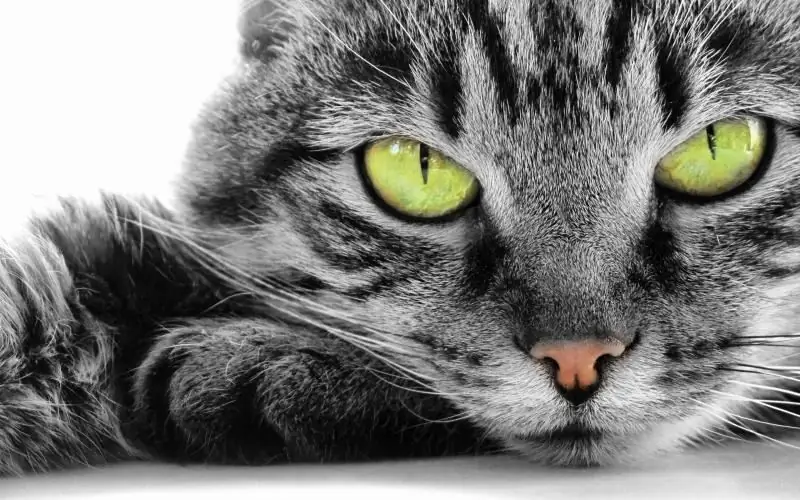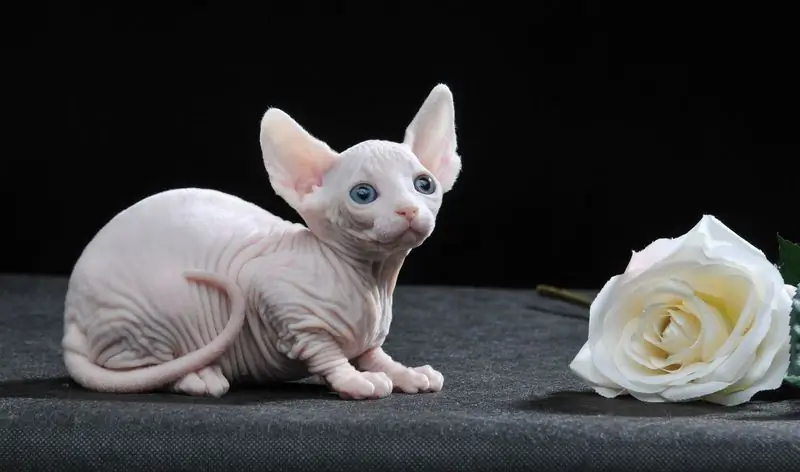
Table of contents:
- Author Bailey Albertson [email protected].
- Public 2024-01-17 22:26.
- Last modified 2025-01-23 12:41.
Why do cats need "pockets" on their ears

All cats have specific skin folds on their ears, at their very base on the outside. These are the so-called "pockets". Nature never creates anything for nothing. So what are these folds for the mustachioed ones for?
What is the role of the "pockets" on the ears
Until now, scientists do not have a reasonable opinion why cats have specific folds on their ears. There are only different assumptions based on long-term observations of these animals.
Sound trap
One of the common hypotheses says that the "pockets" on the ears serve as a kind of catcher of sound waves. Their location on the outer edge of the auricle is exactly what it is for. With the help of folds, sound is more accurately directed to the inner ear, where it is analyzed. The theory is very plausible, because cats hear even those rustles that the human ear cannot distinguish.
The stock of maneuverability of the auricle
According to another version, the folds in the ear allow the cat to twist this organ with a greater amplitude, which can reach 180 degrees. This allows the animal to better pick up sounds coming from different directions, which primarily serves the safety of the animal.
Valve
Another version is that very sensitive nerve receptors are hidden under the thin folds of the "pocket". As soon as an external stimulus acts on them, the ear closes (or sometimes the cat just shakes it, trying to remove the annoying factor).

A cat's ears can reflexively snap shut if exposed to an external stimulus
Cats have been in my house for most of my life. Of course, the experience of observing their behavior is rather big. Sometimes you can see the following picture: a cat is sleeping, and an annoying fly is trying to land on its ear. As soon as the fly flies close to the ear, it shakes itself. Maybe, indeed, this is due to the "pocket" that catches the approach of a foreign object and protects this important organ from intrusions.
Remains of undeveloped gills
This theory is based on the similarity of the embryos of mammals and aquatic vertebrates, which at one of the stages of development have common structural features, namely, the gill sacs. Naturally, cats do not need them, therefore, as a result of further development, they are transformed into folds in the ear. It is a rudimentary element, that is, it does not play any role in the life of the animal. True, this version, no matter how interesting it may sound, has not yet been confirmed by any research.

All vertebrates at a certain stage of development have gill sacs (in the photo - №4)
Regardless of the true purpose of the folds on the ears of a cat, they require care, as does the entire outer part of the ear. They should be wiped with a damp cotton pad during hygiene procedures, but you should not get inside the "pocket".
What other animals have "pockets" on their ears
Cats are not the only creatures with such an interesting outer ear structure. Similar "pockets" are found in bats, foxes, and some dog breeds. There is also no clarity about their purpose.
Photo gallery: animals with folds on the auricle, like cats
-

Fox muzzle -
Foxes have excellent hearing, detecting mouse movements under a thick layer of snow
-

Bat - The bat's hearing is unique, it distinguishes overlapping sounds, the difference between which is 2 millionth of a second
-

Dog's ears are cleaned - A dog, like a cat, can control ear movements using the ear muscles.
Since animals with the same "pockets" on their ears as cats have developed hearing, the theory that these folds are designed to capture and redirect sound waves into the inner ear can be considered the closest to the truth. In fact, nature is hardly mistaken, it is just that people still cannot figure out what she has in mind, creating "pockets" on the ears of cats.
Recommended:
Bald Cats: Popular Breeds, Their Descriptions And Photos, How To Care For And Feed Cats, Owner Reviews

The history of the appearance of cats without hair. Bald cat breeds. Features of caring for an unusual pet. Photo, video. Reviews
What Breeds Of Cats Are: The Name Of Rare Cats, Classification By The Length And Type Of Wool, Color, Type Of Ears And Tail, Photographs

The origin of cat breeds. Their classification is based on external features. A variety of species. Rare breeds of cats. How to identify the breed
Dwarf Cats And Cats: What Breed Is Recognized As The Smallest In The World, The Peculiarities Of Their Maintenance And Breeding, The Nuances Of Choosing A Pet

Dwarf cat breeds, their weight and features. Which breed is recognized as the smallest. The smallest cat in the world. Problems of dwarf breeds. Photo and video
Whiskers In Cats And Cats: What Are They Called Correctly And Why They Are Needed, What Will Happen If You Cut Them And Why They Fall Out Or Become Brittle

Features of the structure of the mustache in cats. What are they called and where they are located. What functions do they perform. What problems can a cat with a mustache have? Reviews
Why Cucumbers Have Pimples And Why Are They Needed

Why. Cucumbers are smooth and pimpled. Why does a cucumber need pimples. Which cucumbers are best for pickling, and which ones for salad
